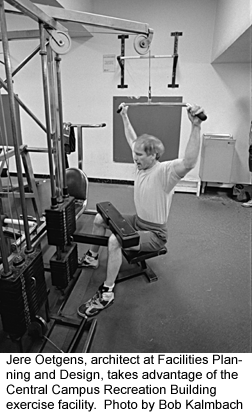The University Record, May 20, 1997
Home Gym tips help get peak performance
from wallet, too
By Deborah Gilbert
News and Information Services
 Pressed for time and money but need to exercise? Set up a basic home gym that combines aerobic and strength training. “But make the investment worth while,” says Charles Kuntzleman, adjunct associate professor of kinesiology. “Shop carefully so you get peak performance from your wallet, too.”
Pressed for time and money but need to exercise? Set up a basic home gym that combines aerobic and strength training. “But make the investment worth while,” says Charles Kuntzleman, adjunct associate professor of kinesiology. “Shop carefully so you get peak performance from your wallet, too.”
Kuntzleman, with the assistance of 50 exercise specialists—physiologists, body builders, runners, cyclists, coaches, nurses and physicians—evaluated 130 pieces of indoor exercise equipment for Consumers Digest. He offers the following tips.
Go to a specialty store. “No matter what you buy, go to an exercise equipment specialty store. Specialty stores carry the best products, have the most knowledgeable staff and will provide service, including delivery, assembly and repairs. And buy the best you can afford so you enjoy using it and it doesn’t break down.”
Think twice about buying machines that require you to change cables or reconfigure them to do different exercises.
The minimal gym. “A home gym needs at least two components—an aerobic machine, such as a bike, cross country skier or treadmill, and a set of free weights,” Kuntzleman says. “If you can afford it, you might want to purchase a multistation exercise machine.”
Free weights. Consider a starter set of free weights that includes about 200 pounds of plates ranging from one to 25 pounds, two bars for dumbbells and one bar for a barbell. “Check the actual weight. Cheap plates can be off by half a pound,” Kuntzleman cautions.
Invest in a bench that is at least 36 inches wide for stability and support. Look for 2-inch steel tubing and a good quality covering. “The best benches ($200) can be set at an incline,” he adds.
Treadmills. Kuntzleman discourages new exercisers from purchasing non-motorized treadmills. While they start at about $300, most are set on a sharp incline that beginners find very demanding. The less expensive ones also have treads that rest on rollers that heat up and give walkers a “hot foot.”
Motorized treadmills ($1,000-$3,000) should have a motor with at least 1.5 horsepower that is labeled for “continuous duty.” Avoid machines held together with too many bolts. The treads should be at least 50 inches long and 18 inches wide, minimum, and you should be able to elevate and lower it to simulate hills and flats.
Stationary bikes. Stationary bikes ($300-$1,500) should be sturdy and comfortable. Avoid the kind with caliper brakes, which slow the wheel by pressing on the rim. “These wear out fairly quickly,” Kuntzleman explains.
Another bike option is air resistance from a built-in fan. Many models also have movable handlebars to keep the upper body moving, too. They are more expensive but more comfortable. A final choice is magnetic resistance—very smooth and quiet, but expensive.
Stair climbers. Decide whether you want a stepper (lower body only) or a climber (upper and lower body workout), and whether you want pedals that move in tandem (as one goes up the other goes down automatically) or move independently. “They are both equally effective so choose what seems comfortable,” Kuntzleman says.
Test machines for at least 15 minutes for stability, smoothness and comfort. “Your feet
should not tingle or feel odd and you should not have to bend over.”
Rowers. The best machines (about $700) use a fanlike flywheel that is attached to a cable or belt rather than hydraulic or pneumatic cylinders. “Make sure you have room for a rower, which is often 8 feet long.”
Cross-country skiers. Good models ($400-$600) are some of the best fitness bargains available because you use both your arms and legs. Like stair climbers, you can get models with independent or tandem foot movement.
Multistation exercise machines. Before you buy a multistation exercise machine, “measure your floor space and ceiling height. Some machines need 7 feet of overhead clearance,” Kuntzleman cautions. There are two basic kinds of multistation machines: machines with cables and stacks of weights ($700-$2,200) and machines that depend on resistance from bungee cords, springs, or pneumatic or hydraulic cylinders ($300-$2,000).
“The weight machines are generally more sturdy, durable and biomechanically sound than the resistance machines, but they also are more expensive, Kuntzleman says.”

